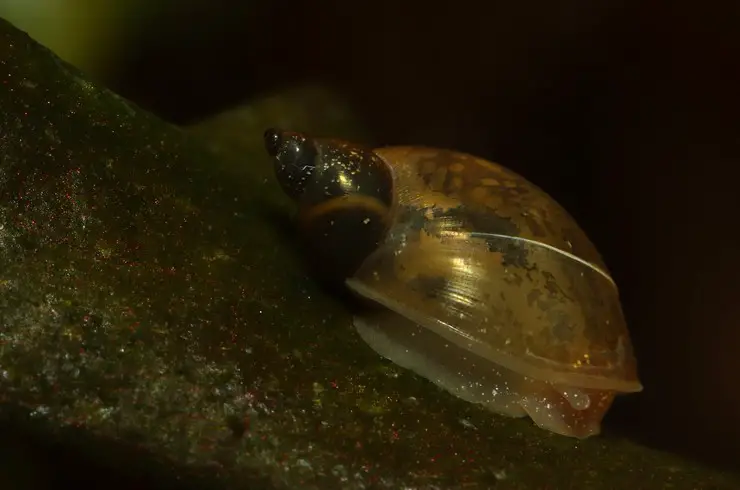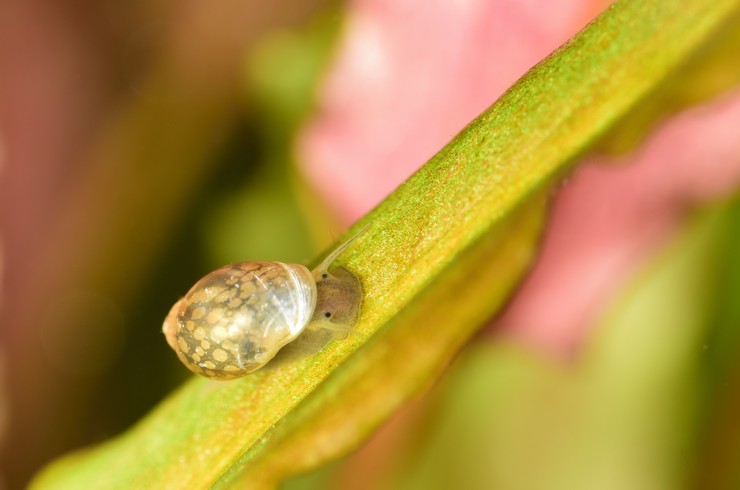Sometimes unwanted guests may appear in the aquarium and begin to spoil the underwater garden grown by their own labor. Fiza snails are a typical example of these species. Once in the aquarium, they begin to actively multiply and spoil the plants, gnawing holes in them. But for some lovers, the color of the mollusks seems extremely attractive, and they themselves keep the snails. Is it easy to keep these underwater inhabitants at home? You will find the answer in our article.
General information
Physa sp. Is a genus of freshwater gastropod mollusks that can often be found in aquariums. They can get here in different ways: some amateurs set them on purposefully in order to diversify their underwater world, to others they get “hares” along with plants or decorations from another aquarium (more often than not, this happens).
Among hobbyists, the attitude towards fiza snails is ambiguous. Someone thinks that they not only decorate the aquarium but also bring tangible benefits. Others are categorically against such cohabitation due to uncontrolled reproduction and the ability to damage the leaves of living plants.
Despite a completely aquatic lifestyle, fiza snails do not have gills. Breathing is carried out only by the lungs and partially through the mantle. Among the unusual features of snails is the ability to create special slimy cords on the walls of the aquarium. They serve as a kind of “elevators” that allow the mollusks to quickly rise to the surface for another breath of air. These slimy filaments last up to 20 days in the aquarium. They can be used not only by the individual who created them but also by any other physa living in the aquarium. Also, in all likelihood, they serve as boundaries of territories.
Fiza snails are hermaphrodites, which explains the high breeding rates and uncontrolled growth of the shellfish population in the aquarium. It is quite difficult to withdraw an unwanted guest. Snails do not have a special decorative function.
Appearance
Fiza is miniature snails. The size of the shell of these mollusks does not exceed 2 cm in length. Its shape is ovoid, left-handed by 3-4 turns with pronounced sutures between them. The shell wall is smooth and thin, so it seems almost transparent from the outside. There is no cap covering the mouth.
The color of the “house” in nat varies from yellowish to brown, often with numerous spots or strokes.
The leg is broad and blue-black. In the head part, there are filamentous tentacles, at the base of which the organs of vision are located.
Habitat
Fiza snails are widespread in southern Europe, North Africa, Central, and East Asia. This is facilitated by the unpretentiousness of the snail and the rapid rate of reproduction.
Mollusks live at shallow depths (1-1.5 m) not far from the coast. They prefer well-warmed waters with a slow current, as well as stagnant reservoirs – lakes, and ponds. Due to a large amount of aquatic vegetation at such depths, a lot of litter and organic remains are formed at the bottom.
Care and maintenance
It is very simple to keep nat at home. If you want to have them in a separate aquarium, then make sure that one snail has at least 1 liter of water. These mollusks do not have special requirements for the aquarium or ground. Unless it is worth covering it with a lid to avoid escaping while leaving a small air gap because mollusks need to constantly replenish their oxygen reserves since they do not have gills.
Fiza snails love clean water, so a suitable filter should be installed in the aquarium and quality aeration should be provided. Do not forget about regular weekly changes up to 20% of the volume of the aquarium. Snails are indifferent to the level of lighting.
As for the water parameters, the temperature should be maintained at 20-28 ° С, medium hardness (5-15 DH), and pH = 6.5-8.0. The fact is that in soft and acidic water, the shell of snails can be destroyed. In cold water (less than 20 ° C), the metabolism slows down and the physicists freeze.
Compatibility
You can keep nat both with other non-predatory snails and with calm species of fish. Zebrafish, guppies, tetras, neons, corridors, etc. will become good neighbors. But it is better to exclude large predatory fish and lovers of mollusks (tetrapods, bocci, macropods) from possible neighbors. The predatory snails of Helena, which will deal with small relatives in a matter of days, are categorically not suitable for joint keeping with fiza. Ancistrus sticky catfish eat well small natal eggs, which allows them to naturally regulate their numbers.
Prevent nat from spawning aquariums from spawning fish. Snails violate the covers of eggs, from which the latter can die.
Finally, physicals are not at all suitable for keeping in herbal aquariums. Unfortunately, by eating up algae on the surface of the leaves, snails do not spare them. Perforated and deformed leaves are common in plants with fiza tanks.
Feeding snails nat
Fiza snails do not differ in special gastronomic preferences and eat any pasture in the aquarium: the remains of fish food, algae, rotted plant leaves. Additional feeding is possible with sinking catfish tablets (Tetra Pleco Spirulina Wafers). But we must not forget that increased feeding will certainly increase the intensity of snail breeding.
Reproduction and breeding
It is not required to create special conditions for the reproduction of nat. These snails are hermaphrodites, meaning that each individual contains both male and female gender glands. During mating, two individuals cross-exchange reproductive fluid with each other. Therefore, for the reproduction of snails, only two individuals will be enough.
After fertilization, snails lay several clutches of eggs at short intervals, enclosed in a mucous membrane. At a time, the mollusk is capable of laying up to 20 eggs about 5 mm in size. Incubation lasts about two weeks, after which small snails with a small shell are born. They are invisible and easily transferred from one aquarium to another on plant leaves. They feed on dead organic matter and bacterial film.
Breeding takes place all year round under suitable conditions.
